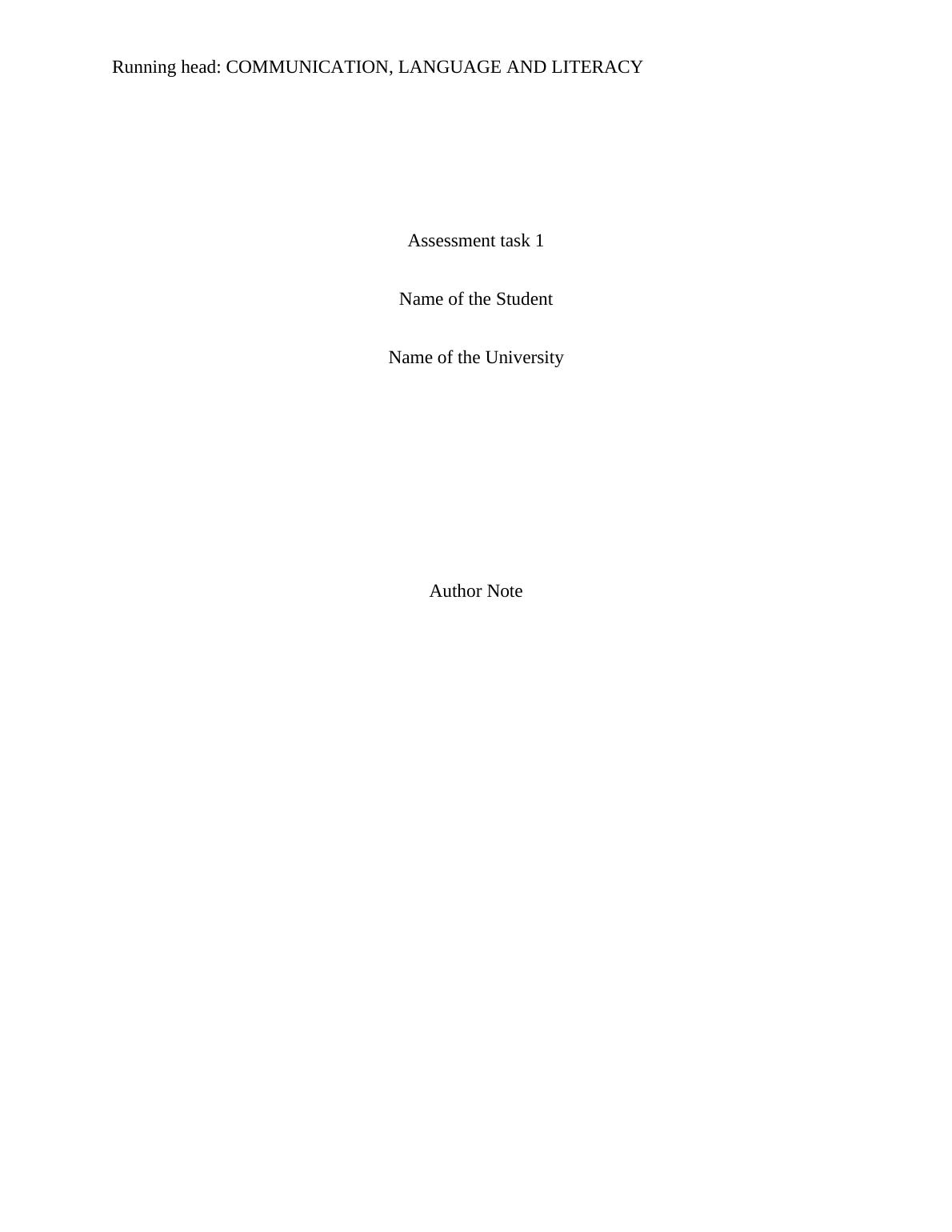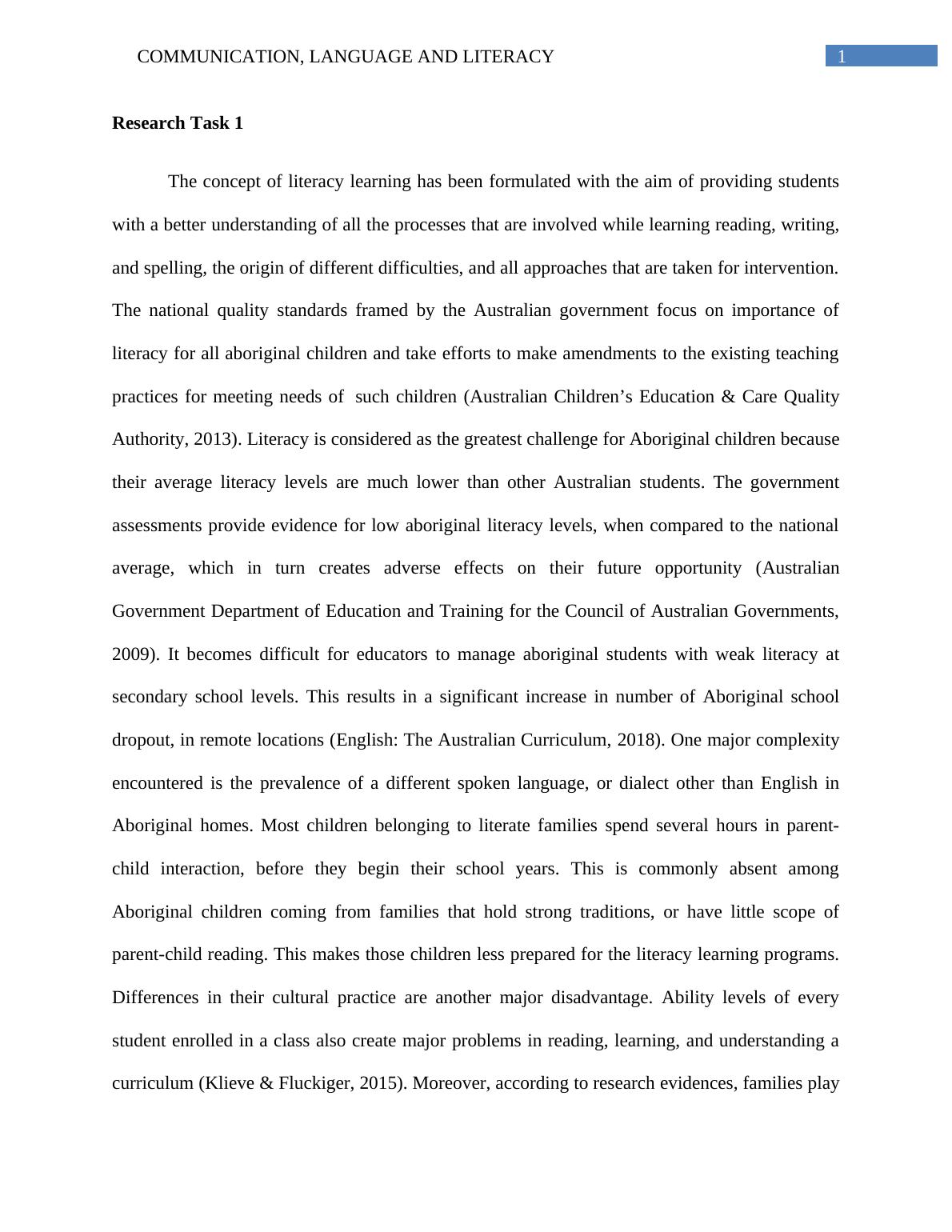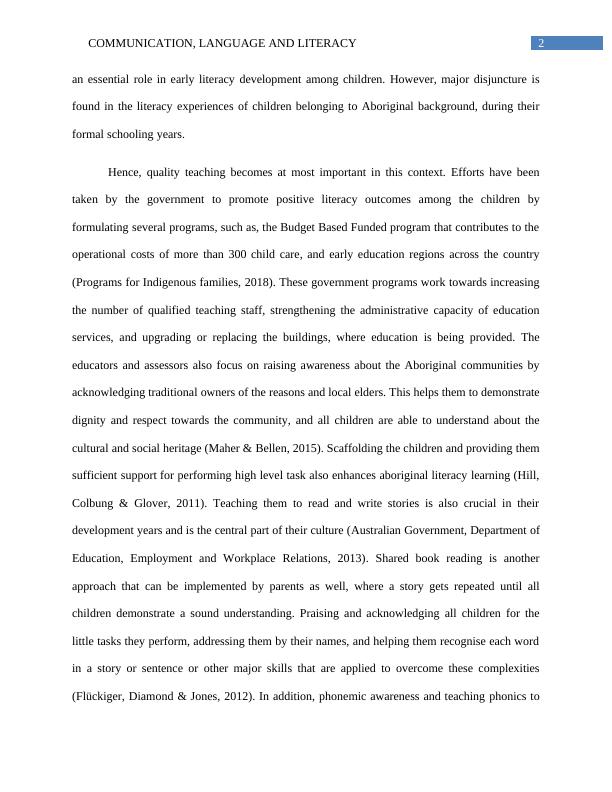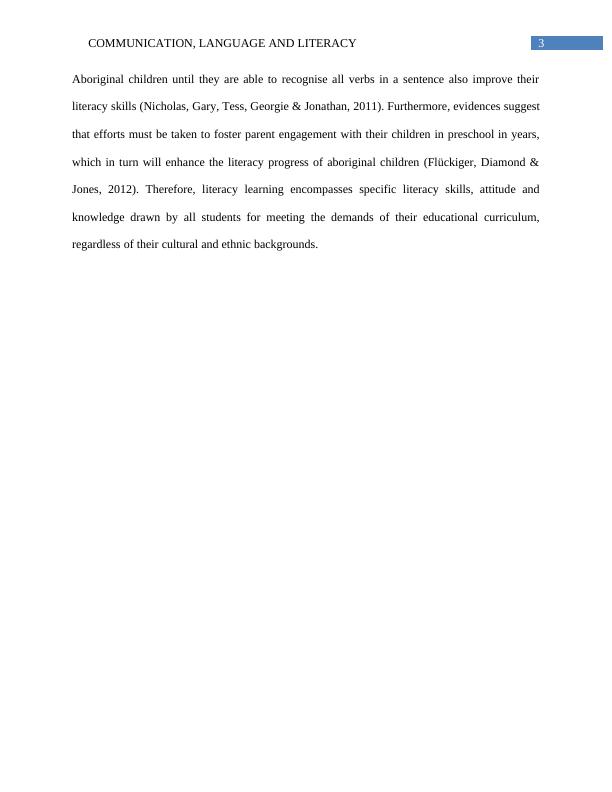Communication, language and literacy
Added on 2021-04-17
11 Pages2347 Words126 Views
Running head: COMMUNICATION, LANGUAGE AND LITERACYAssessment task 1Name of the StudentName of the UniversityAuthor Note

1COMMUNICATION, LANGUAGE AND LITERACYResearch Task 1The concept of literacy learning has been formulated with the aim of providing studentswith a better understanding of all the processes that are involved while learning reading, writing,and spelling, the origin of different difficulties, and all approaches that are taken for intervention.The national quality standards framed by the Australian government focus on importance ofliteracy for all aboriginal children and take efforts to make amendments to the existing teachingpractices for meeting needs of such children (Australian Children’s Education & Care QualityAuthority, 2013). Literacy is considered as the greatest challenge for Aboriginal children becausetheir average literacy levels are much lower than other Australian students. The governmentassessments provide evidence for low aboriginal literacy levels, when compared to the nationalaverage, which in turn creates adverse effects on their future opportunity (AustralianGovernment Department of Education and Training for the Council of Australian Governments,2009). It becomes difficult for educators to manage aboriginal students with weak literacy atsecondary school levels. This results in a significant increase in number of Aboriginal schooldropout, in remote locations (English: The Australian Curriculum, 2018). One major complexityencountered is the prevalence of a different spoken language, or dialect other than English inAboriginal homes. Most children belonging to literate families spend several hours in parent-child interaction, before they begin their school years. This is commonly absent amongAboriginal children coming from families that hold strong traditions, or have little scope ofparent-child reading. This makes those children less prepared for the literacy learning programs.Differences in their cultural practice are another major disadvantage. Ability levels of everystudent enrolled in a class also create major problems in reading, learning, and understanding acurriculum (Klieve &Fluckiger, 2015). Moreover, according to research evidences, families play

2COMMUNICATION, LANGUAGE AND LITERACYan essential role in early literacy development among children. However, major disjuncture isfound in the literacy experiences of children belonging to Aboriginal background, during theirformal schooling years. Hence, quality teaching becomes at most important in this context. Efforts have beentaken by the government to promote positive literacy outcomes among the children byformulating several programs, such as, the Budget Based Funded program that contributes to theoperational costs of more than 300 child care, and early education regions across the country(Programs for Indigenous families, 2018). These government programs work towards increasingthe number of qualified teaching staff, strengthening the administrative capacity of educationservices, and upgrading or replacing the buildings, where education is being provided. Theeducators and assessors also focus on raising awareness about the Aboriginal communities byacknowledging traditional owners of the reasons and local elders. This helps them to demonstratedignity and respect towards the community, and all children are able to understand about thecultural and social heritage (Maher &Bellen, 2015). Scaffolding the children and providing themsufficient support for performing high level task also enhances aboriginal literacy learning (Hill,Colbung & Glover, 2011). Teaching them to read and write stories is also crucial in theirdevelopment years and is the central part of their culture (Australian Government, Department ofEducation, Employment and Workplace Relations, 2013). Shared book reading is anotherapproach that can be implemented by parents as well, where a story gets repeated until allchildren demonstrate a sound understanding. Praising and acknowledging all children for thelittle tasks they perform, addressing them by their names, and helping them recognise each wordin a story or sentence or other major skills that are applied to overcome these complexities(Flückiger, Diamond & Jones, 2012). In addition, phonemic awareness and teaching phonics to

3COMMUNICATION, LANGUAGE AND LITERACYAboriginal children until they are able to recognise all verbs in a sentence also improve theirliteracy skills (Nicholas, Gary, Tess, Georgie & Jonathan, 2011). Furthermore, evidences suggestthat efforts must be taken to foster parent engagement with their children in preschool in years,which in turn will enhance the literacy progress of aboriginal children (Flückiger, Diamond &Jones, 2012). Therefore, literacy learning encompasses specific literacy skills, attitude andknowledge drawn by all students for meeting the demands of their educational curriculum,regardless of their cultural and ethnic backgrounds.

End of preview
Want to access all the pages? Upload your documents or become a member.
Related Documents
Advantages and Disadvantages of Phonics and Whole Language Approacheslg...
|9
|1527
|344
Evidence of Learning Using action Learning Principleslg...
|12
|2842
|65
EPE520: Developmental Learning and Pedagogy Assessment 2022lg...
|9
|3445
|20
Literacy learning for Aboriginal Children and Phonics Assignmentlg...
|7
|1766
|33
Challenges and Strategies for Literacy Learning in Aboriginal Childrenlg...
|10
|2164
|373
(PDF) What is Action Learning?lg...
|14
|4737
|43
